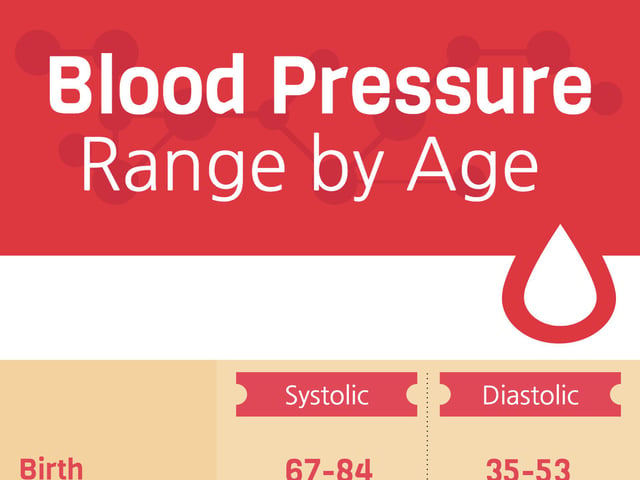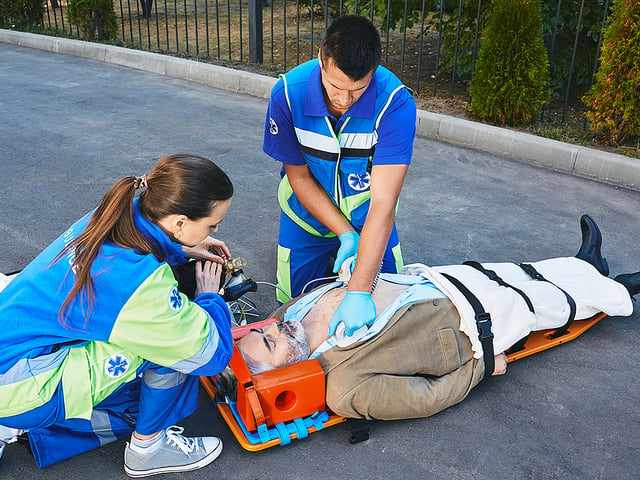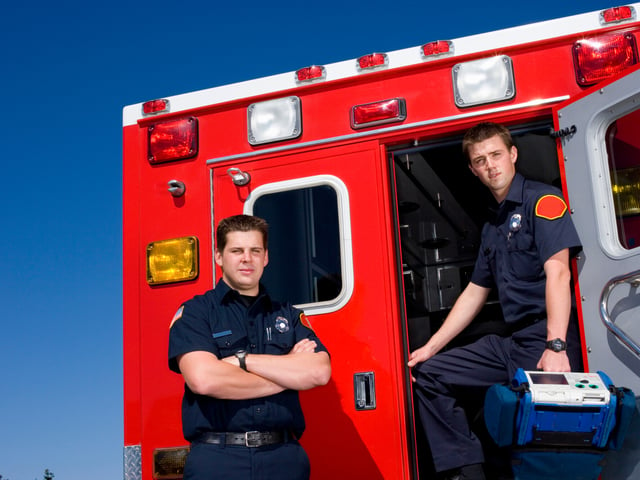
Blood Pressure Range by Age
Emergency Medical Technicians (EMTs) help hospitals save countless lives each year. If you want to become an EMT, it’s critical to know the normal ranges for vital signs.
Blood pressure is one of the most critical vital signs EMTs assess. Why is blood pressure significant? What is considered normal blood pressure?
If you’re studying for the EMT test, you’ll need to know more about this measurement than memorizing quick reference numbers. Our essential blood pressure guide will help you answer questions and learn how it factors into hands-on patient assessments.
What is Blood Pressure?
Blood pressure is a concept you may have learned during anatomy basics in middle school. Your heartbeat pumps blood throughout your cardiovascular system, providing the force that pushes it along with each pulse.
Your blood creates pressure against your blood vessel walls as it pulses, similar to a garden hose that becomes stiffer as water moves through it. Blood pressure monitors measure this pulsing force as it moves through your arteries.
As with water through a garden hose, high or low pressure can negatively affect your blood flow and blood vessel walls. Abnormal blood pressure is also an indicator of many health-related risks. These risks can include:
-
Hypotension (low BP)
-
Hypertension (high BP)
-
Arrhythmias
-
Pulmonary embolism
-
Hemorrhaging
-
Dehydration
-
Allergic reactions
-
Nutrition deficiencies
-
Anemia
-
Diabetes
-
Parkinson’s disease
-
Heart disease
-
Heart attack
-
Stroke
-
Kidney disease
-
Lung issues
-
Thyroid issues
-
Drug or alcohol abuse
Blood pressure is never static and varies constantly. It’s affected by factors like the time of day, temperature, stressful situations, and what you eat or drink. It can also change as you move between standing up, sitting, and lying down.
Even with these constant changes, blood pressure should fall within a healthy range. Therefore, measuring blood pressure accurately is essential, especially with related health risks like hypertension or trauma.
How to Measure Blood Pressure
Blood pressure is generally measured using a modern medical sphygmomanometer. This device is referred to more simply as a blood pressure monitor, cuff, or gauge. It has three main parts:
-
An inflatable cuff
-
A pressure reader (manometer)
-
A stethoscope (manual versions) or, a digital machine (automatic versions)
Most cuffs are designed to go around the upper arm, but some cuffs can be used on fingers or wrists. The cuff is inflated until it puts pressure on your blood flow.
Once the flow is stopped, the cuff is slowly deflated. This process allows a manometer to measure how much pressure your blood exerts with your heartbeat (systolic pressure) and how much it exerts between heartbeats (diastolic pressure).
Manual blood pressure manometers use a mercury column or an aneroid dial for measurements. Automatic blood pressure monitors use digital displays.
How to Read Blood Pressure Measurements
Blood pressure is typically measured using millimeters of mercury (mm Hg). This unit is the medical standard, even if the blood pressure monitor doesn’t use actual mercury.
These numbers relate to how high liquid mercury rises in the column, similar to old-school mercury thermometers. For example, a readout of 130 means the blood pressure can move liquid mercury 130 millimeters (or 13 centimeters) up the gauge.
Blood pressure readings can be separate numbers or expressed in fraction form. For example, you may see it written as “124/77” or hear it referred to as “124 over 77.”
The higher number is the systolic pressure, and the lower number is the diastolic pressure. Although diastolic pressure can be higher than usual on its own, it cannot go higher than systolic pressure without extreme circumstances.
Normal Blood Pressure
The current normal blood pressure standard for adults is:
-
Systolic pressure: less than 120
-
Diastolic pressure: less than 80
If a blood pressure result comes out over 120/80 mm Hg, however, this doesn’t always mean someone has consistently high blood pressure.
Stimulants like caffeine may temporarily spike blood pressure. Many patients will also have higher results at a hospital or clinic than at home due to the effects of anxiety and stress.
This phenomenon is referred to as “white-coat syndrome” after the professional uniform associated with doctors. White-coat syndrome may be isolated or a forerunner to hypertension.
What is Hypertension?
Hypertension is consistently high blood pressure above 130/80 mm Hg. Using the garden hose analogy, imagine what happens to a hose when too much water pressure is forced through over a long period.
The hose will become overly stiff and lose its elasticity. It may develop bulges and leaks. The impacted flow will allow mineral deposits to build up, causing blockages.
Hypertension similarly leads to long-term heart and artery damage. Plaque deposits can form and further impact your blood flow.
Your organs depend on nutrient and oxygen-rich blood circulation to keep functioning. High blood pressure doesn’t just damage your heart and blood vessels. It can also affect other major organs like your brain, kidneys, and eyes.
Although low blood pressure also has associated risks, hypertension is a more common and chronic issue. Nearly 50% of all U.S. adults experience hypertension.
Blood Pressure Ranges
The American Heart Association currently uses five blood pressure categories for adults:
-
Normal: less than 120 systolic and less than 80 diastolic
-
Elevated: 120-129 systolic and less than 80 diastolic
-
Hypertension Stage I: 130-139 systolic or 80-89 diastolic
-
Hypertension Stage II: +140 systolic or +90 diastolic
-
Hypertensive Crisis: +180 systolic and/or +120 diastolic
One high blood pressure reading doesn’t always equal hypertension, but healthcare providers use these numbers as a baseline to look deeper into their patient’s health.
Each category comes with different management strategies. Healthcare providers evaluate the patient to reduce the risk of serious complications. Heart disease is currently the leading cause of death in the U.S.
Elevated
The elevated category indicates a patient is on track to developing hypertension. Healthcare providers may recommend lifestyle changes to lower these numbers or keep them from pushing higher.
These changes can include:
-
Losing weight
-
Increasing exercise
-
Eating a healthier diet
-
Lowering salt intake
-
Lowering alcohol consumption
-
Smoking cessation
-
Addressing drug addictions
-
Improving sleep hygiene
-
Reducing stress and anxiety
Diet, exercise, and weight are the top three factors for managing elevated blood pressure. A healthy diet and even a modest exercise routine can reduce weight and improve heart health.
Hypertension Stage I
Hypertension Stage I is also referred to as prehypertension. This means the risk of developing hypertension has increased to a critical level.
This category also increases the risk of developing cardiovascular diseases. Prehypertension can occur with other related issues like obesity or diabetes, further increasing the likelihood of heart-related health risks.
If the risk is high, healthcare providers may prescribe blood pressure medication and recommend lifestyle changes. Blood pressure medications include:
-
Diuretics
-
ACE inhibitors
-
Alpha-blockers
-
Beta-blockers
-
ARBs
-
Calcium channel blockers
-
Alpha-2 receptor agonists
-
Vasodilators
-
Renin-inhibitors
-
Peripheral adrenergic inhibitors
These medications come with various side effects. They may also work differently depending on individual factors. This means patients may have to try more than one medication type to find the most effective treatment.
Hypertension Stage II
Hypertension Stage II is the highest stage before critical care is necessary. Medication and lifestyle changes are crucial at this stage to avoid severe issues like heart attacks and strokes.
Healthcare providers may also recommend home monitoring systems. This will help patients know if they have reached urgent or emergency care levels.
Hypertensive Crisis
A hypertensive crisis is a stage where quick medical intervention is necessary. This term refers to two conditions:
-
Hypertensive urgency
-
Hypertensive emergency
Hypertensive urgency is characterized by abnormally high blood pressure but no symptoms of organ damage. Patients may require urgent care to bring their blood pressure back down over several hours or 1-2 days.
A hypertensive emergency has abnormally high blood pressure along with symptoms of organ distress and failure. These include:
-
Blurred or impacted vision
-
Headaches
-
Abnormal heartbeat
-
Chest pains
-
Nausea and dizziness
-
Nose bleeds
-
Seizures
-
Trouble breathing
-
Anxiety or agitation
-
Confusion
-
Unresponsiveness
Patients experiencing a hypertensive emergency need someone to call 911 to prevent irreversible organ damage or death. As an EMT, you may have to assess and respond to an ongoing hypertensive crisis.
Normal Blood Pressure By Age
When assessing a medical emergency, it’s also vital to know normal blood ranges by age group. Children and teenagers have lower blood pressure ranges than adults. A low blood pressure reading for an adult may be normal for younger patients.
A newborn in crisis will also have very different distress indicators than a senior. Knowing the correct range for blood pressure can help you evaluate their other vital signs and symptoms.
-
Birth: 67-84 systolic and 35-53 diastolic
-
Infant (1 month-1 year): 72-104 systolic and 37-56 diastolic
-
Toddler (1-2 years): 86-106 systolic and 42-63 diastolic
-
Preschooler (3-5 years): 89-112 systolic and 46-72 diastolic
-
School-aged child (6-9 years): 97-115 systolic and 57-76 diastolic
-
Pre-adolescent (9-11 years): 102-120 systolic and 61-80 diastolic
-
Adolescent (11-15 years): 110-131 systolic and 64-83 diastolic
Younger children are more likely to have abnormal blood pressure because of health issues versus factors like diet and exercise. For example, newborns may have high blood pressure due to congenital conditions or maternal drug exposure.
Ready to Become an EMT? Boost Your Test-Taking Success Today!
Blood pressure is an essential indicator of a body’s health and functioning. Normal blood pressure depends on age, but too many adults have persistently high blood pressure.
Are you studying for the EMT test? You’ll need practical hands-on skills, in-depth blood pressure knowledge, and many other patient assessment factors. Check out our free practice tests, study guides, and flashcards to see if you’re ready!

Keep Reading

Emergency Medical Technician Test Blog
How Many Questions are on the NREMT?
The National Registry of Emergency Medical Technicians (NREMT) exam is …

Emergency Medical Technician Test Blog
How Hard is the EMT Test?
EMTs (Emergency Medical Technicians) are required to have strong medica…

Emergency Medical Technician Test Blog
What Is a Passing Score on the NREMT Exam?
The job outlook for EMTs and paramedics is strong. The Bureau of Labor …